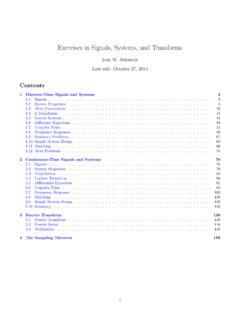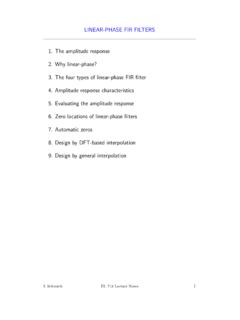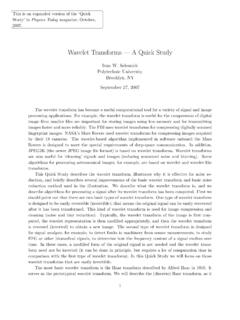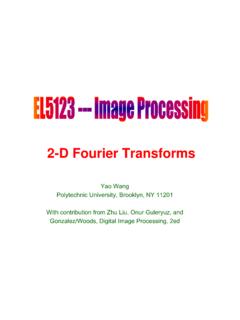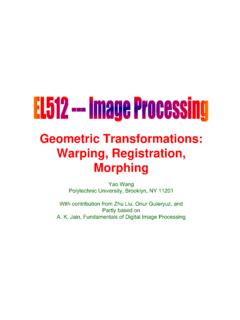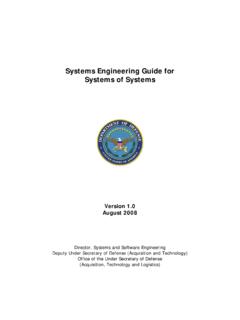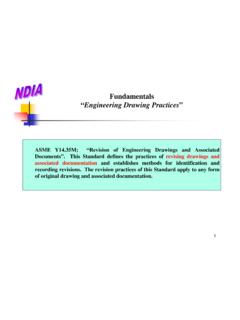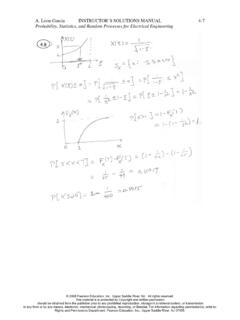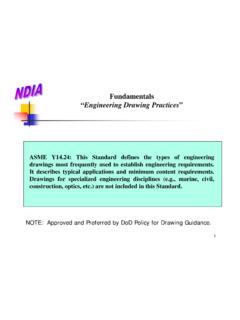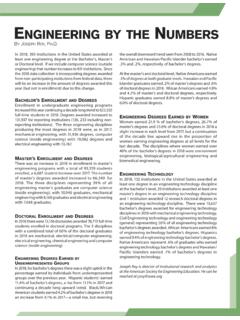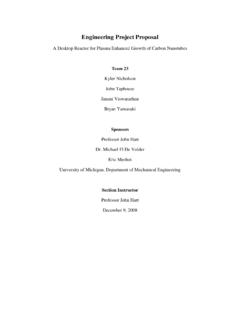Transcription of Fourier Transform: Important Properties
1 EE3054 Signals and SystemsFourier Transform: Important PropertiesYao WangPolytechnic UniversitySome slides included are extracted from lecture presentations prepared by McClellan and Schafer4/4/2008 2003, JH McClellan & RW Schafer2 License Info for SPFirst Slides This work released under a Creative Commons Licensewith the following terms: Attribution The licensor permits others to copy, distribute, display, and perform the work. In return, licensees must give the original authors credit. Non-Commercial The licensor permits others to copy, distribute, display, and perform the work. In return, licensees may not use the work for commercial purposes unless they get the licensor's permission. Share Alike The licensor permits others to distribute derivative works only under a license identical to the one that governs the licensor's work. Full Text of the License This (hidden) page should be kept with the presentationLECTURE OBJECTIVES Basic Properties of Fourier transforms Duality, Delay, Freq.
2 Shifting, Scaling Convolutionproperty Multiplicationproperty Differentiation property Freq. Response of Differential Equation System4/4/2008 2003, JH McClellan & RW Schafer4 Fourier Transform Defined For non-periodic signalsFourier SynthesisFourier Analysis =dtetxjXtj )()( = dejXtxtj)()(21 Table of Fourier Transforms)()()()cos()(cccjXttx ++ = =1)()()(= = jXttx > <= =bbbjXtttx 01)()sin()(2/)2/sin()(2/02/1)( TjXTtTttx= > <= jjXtuetxt+= = 11)()()()(2)()(ctjjXetxc = =)()()()sin()(cccjjjXttx ++ = =0)()()(0tjejXtttx = =4/4/2008 2003, JH McClellan & RW Schafer6 Duality of FT Pairs =dtetxjXtj )()( = dejXtxtj)()(21())(2)( Then )( If xtggtx4/4/2008 2003, JH McClellan & RW Schafer7 Fourier Transform of a General Periodic Signal If x(t)is periodic with period T0 , ===00000)(1)(TtjkkktjkkdtetxTaeatx )(2 since Therefore,00 ketjk = =kkkajX)(2)(0 4/4/2008 2003, JH McClellan & RW Schafer8 Square Wave Signal x(t)=x(t+T0)
3 T0 2T0 T02T00tak=e j 0kt j 0kT00T0/2 e j 0kt j 0kT0T0/2T0=1 e j kj kak=1T0(1)e j 0ktdt+1T0( 1)e j 0ktdtT0/ 2T0 0T0/2 4/4/2008 2003, JH McClellan & RW Schafer9 Square Wave Fourier TransformX(j )=2 ak ( k 0)k= x(t)=x(t+T0)T0 2T0 T02T00t4/4/2008 2003, JH McClellan & RW Schafer10FT of Impulse Train The periodic impulse train isp(t)= (t nT0)=n= akejk 0tn= ak=1T0 (t)e j 0tdt= T0/ 2T0/2 1T0 for all k P(j )=2 T0 (k= k 0) 0=2 /T0 Plot of impulse train in time and frequency4/4/2008 2003, JH McClellan & RW Schafer12 Table of Easy FT Propertiesax1(t)+bx2(t) aX1(j )+bX2(j )x(t td) e j tdX(j )x(t)ej 0t X(j( 0))Delay PropertyFrequency ShiftingLinearity Propertyx(at) 1|a|X(j( a))ScalingDuality4/4/2008 2003, JH McClellan & RW Schafer13 Delay Propertyx(t td) e j tdX(j )x(t td)e j tdt =x( )e j ( +td)d =e j tdX(j )For example, e a(t 5)u(t 5) e j 5a+j 4/4/2008 2003, JH McClellan & RW Schafer14 Multiply by e^jw0 x(t)ej 0t X(j( 0))))(()()(0)(00 == jXdtetxdtetxetjtjtj4/4/2008 2003, JH McClellan & RW Schafer15 Multiply by cos(w0)?
4 ()()))(())((21)()(21)cos()())(()())(()(0 00000000 ++ +=+ jXjXetxetxttxjXetxjXetxtjtjtjtj4/4/2008 2003, JH McClellan & RW Schafer16 Shifting in frequency by multiply by cos()= (Amplitude Modulation) Illustrate the spectrum in class4/4/2008 2003, JH McClellan & RW Schafer17y(t)=x(t)cos( 0t) Y(j )=12X(j( 0))+12X(j( + 0))x(t)x(t)=1t<T/20t>T/ 2 X(j )=sin( T/ 2) / 2()4/4/2008 2003, JH McClellan & RW Schafer18 Another example x(t)=cos (w0 t) What is y(t)=x(t) * cos (w1 t) Consider w1 >w0 and w1<w0 Verify by trigonometric identities4/4/2008 2003, JH McClellan & RW Schafer19 What about multiply by sin( )?4/4/2008 2003, JH McClellan & RW Schafer20 Scaling Propertyexpands)(shrinks;)2(221 jXtx)()()(1)/(aaadajtjjXexdteatx == )()(1aajXatx 4/4/2008 2003, JH McClellan & RW Schafer21 Scaling Property)()(1aajXatx )2()(12txtx=4/4/2008 2003, JH McClellan & RW Schafer22 Uncertainty Principle Try to make x(t) shorter Then X(j ) will get wider Narrow pulses have wide bandwidth Try to make X(j ) narrower Then x(t) will have longer duration Cannot simultaneously reduce time Cannot simultaneously reduce time duration and bandwidthduration and bandwidth4/4/2008 2003, JH McClellan & RW Schafer23 Table of Easy FT Propertiesax1(t)+bx2(t) aX1(j )+bX2(j )x(t td) e j tdX(j )x(t)ej 0t X(j( 0))Delay PropertyFrequency ShiftingLinearity Propertyx(at) 1|a|X(j( a))Scaling4/4/2008 2003, JH McClellan & RW Schafer24 Significant FT Propertiesx(t) h(t) H(j )X(j )x(t)ej 0t X(j( 0))x(t)p(t) 12 X(j ) P(j )dx(t)dt (j )X(j )
5 Differentiation PropertyDuality4/4/2008 2003, JH McClellan & RW Schafer25 Convolution Property Convolution in the time-domaincorresponds to MULTIPLICATIONMULTIPLICATIONin the frequency-domainy(t)=h(t) x(t)=h( ) x(t )d Y(j )=H(j )X(j )y(t)=h(t) x(t)x(t)Y(j )=H(j )X(j )X(j )4/4/2008 2003, JH McClellan & RW Schafer26 Proof (in class)4/4/2008 2003, JH McClellan & RW Schafer27 Convolution Example BandlimitedInputSignal sinc function Ideal LPF (Lowpass Filter) h(t)is a sinc Outputis Bandlimited Convolve sincs 4/4/2008 2003, JH McClellan & RW Schafer28 Ideally Bandlimited Signal > <= = 10001001)()100sin()(jXtttx 100=b4/4/2008 2003, JH McClellan & RW Schafer29Ex: x(t) and y(t) are both sincsin(100 t) t sin(200 t) t=x(t) h(t) H(j )X(j )sin(100 t) t4/4/2008 2003, JH McClellan & RW Schafer30Ex. x(t) and y(t) are both rect. pulseY(j )=sin( / 2) /2 2y(t)=x(t) h(t)Y(j )=H(j )X(j )4/4/2008 2003, JH McClellan & RW Schafer31 Cosine Input to LTI SystemY(j )=H(j )X(j )=H(j )[ ( 0)+ ( + 0)]=H(j 0) ( 0)+H( j 0) ( + 0)y(t)=H(j 0)12ej 0t+H( j 0)12e j 0t=H(j 0)12ej 0t+H*(j 0)12e j 0t=H(j 0)cos( 0t+ H(j 0)) )cos(*)()(0tthty =4/4/2008 2003, JH McClellan & RW Schafer32 Ideal Lowpass FilterHlp(j ) co coy(t)=x(t) if 0< coy(t)=0 if 0> co4/4/2008 2003, JH McClellan & RW Schafer33 Ideal Lowpass Filtery(t)=4 sin 50 t()+43 sin 150 t()fco "cutoff freq.
6 "H(j )=1 < co0 > co 4/4/2008 2003, JH McClellan & RW Schafer34 Multiplier Multiplication in the time-domain corresponds to convolution in the (j )=12 X(j ) P(j )y(t)=p(t)x(t)X(j )x(t)p(t)Y(j )=12 X(j ) P(j( ))d 4/4/2008 2003, JH McClellan & RW Schafer35p(t)=cos( 0t) P(j )= ( 0) + ( + 0)y(t)=x(t)p(t) Y(j )=12 X(j ) P(j )y(t)=x(t)cos( 0t) Y(j )=12 X(j ) [ ( 0)+ ( + 0)]Y(j )=12X(j( 0))+12X(j( + 0))Multiply by cos(w0 t)4/4/2008 2003, JH McClellan & RW Schafer36 Differentiation Propertydx(t)dt=ddt12 X(j )ej td =12 (j )X(j )ej td Multiply by j dx(t)dt (j )X(j )4/4/2008 2003, JH McClellan & RW Schafer37 Exampleddte atu(t)()= ae atu(t)+e at (t)= (t) ae atu(t) jatueat+ 1)()(1)( jXjjajjaajY=+=+ =4/4/2008 2003, JH McClellan & RW Schafer38 High order differentiation?dx(t)dt (j )X(j )()() jXjdxtxdkkk )(Proof in classSystem of Differential Equation()()()() ==========NkkkMkkkMkkkNkkkMkkkkNkkkkjajb jXjYjHjXjbjYjadttxdbdttyda000000)()()()( )( )()( c4/4/2008 2003, JH McClellan & RW Schafer40 Recall Difference Equation?
7 ()()()() ==========NkkkMkkkMkkkNkkkMkkkkNkkkkjajb jXjYjHjXjbjYjadttxdbdttyda000000)()()()( )( )()( c = = = = ===== = NkkkMkkkMkkkNkkkMkkNkkzazbzXzYzHzXzbzYza knxbknya000000)()()()()( ][][cDiscrete time system (Difference equation)Continuous time system(Differentiation equation)Example systems Example systems described by low order differential equations How to determine the frequency response How to determine the impulse response4/4/2008 2003, JH McClellan & RW Schafer42 Strategy for using the FT Develop a set of known Fourier transform pairs. Develop a set of theorems or Properties of the Fourier transform. Develop skill in formulating the problem in either the time-domain or the frequency-domain, which ever leads to the simplest of Fourier Transforms)()()()cos()(cccjXttx ++ = =1)()()(= = jXttx > <= =bbbjXtttx 01)()sin()(2/)2/sin()(2/02/1)( TjXTtTttx= > <= jjXtuetxt+= = 11)()()()(2)()(ctjjXetxc = =)()()()sin()(cccjjjXttx ++ = =0)()()(0tjejXtttx = =4/4/2008 2003, JH McClellan & RW Schafer44 Table of Easy FT Propertiesax1(t)+bx2(t) aX1(j )+bX2(j )x(t td) e j tdX(j )x(t)ej 0t X(j( 0))Delay PropertyFrequency ShiftingLinearity Propertyx(at) 1|a|X(j( a))ScalingSignificant FT Propertiesx(t) h(t) H(j )X(j )x(t)ej 0t X(j( 0))x(t)p(t) 12 X(j ) P(j )dx(t)dt (j )X(j )Duality()() jXjdxtxdkkk )(READING ASSIGNMENTS This Lecture: Chapter 11, Sects.
8 11-5 to 11-10 Tables in Section 11-9 Other Reading: Entire chap 11
